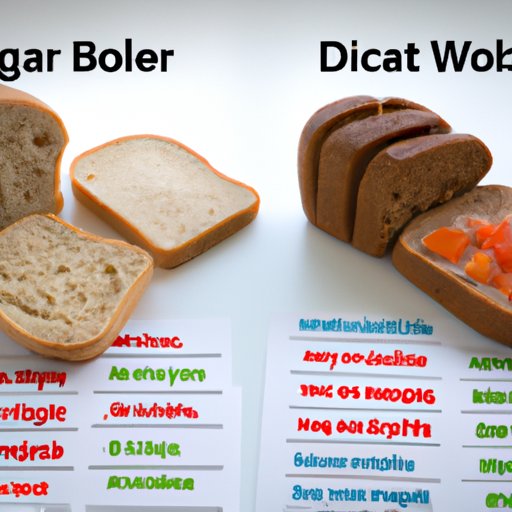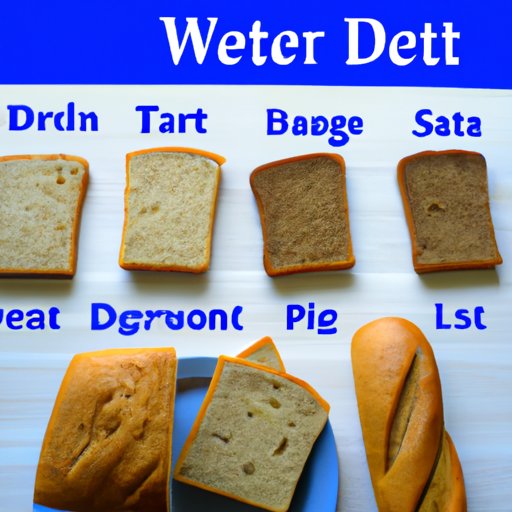Introduction
Diabetes is a chronic condition that affects millions of people around the world. It occurs when the body cannot produce enough insulin or is unable to use the insulin it produces effectively. This leads to high levels of sugar in the blood, which can cause serious health problems if left untreated. People with diabetes need to manage their diet carefully in order to keep their blood sugar levels under control. One food that is often debated among diabetics is wheat bread. Can diabetics eat wheat bread, and if so, what are the benefits and risks? In this article, we’ll explore these questions and provide tips for incorporating wheat bread into a healthy diabetic diet.

Comparing Nutritional Values of Wheat Bread Versus Other Types of Bread for Diabetics
When considering whether wheat bread is an appropriate food for diabetics, it’s important to compare its nutritional values to other types of bread. Here are some key factors to consider:
Glycemic Index (GI)
The glycemic index (GI) is a measure of how quickly a food causes a rise in blood sugar levels. Foods with a high GI are absorbed quickly, while foods with a low GI are absorbed more slowly. Wheat bread typically has a medium to high GI, which means that it may cause a rapid spike in blood sugar levels. However, this can vary depending on the type of wheat bread and other ingredients used in the recipe.
Carbohydrates
Carbohydrates are an important source of energy for people with diabetes. Most types of wheat bread contain fewer carbohydrates than white bread, but it still contains some carbohydrates that can affect blood sugar levels. It’s important for diabetics to monitor their carbohydrate intake and be aware of how much they are consuming in each meal.
Fiber
Fiber is an important nutrient for people with diabetes because it helps slow down the absorption of carbohydrates into the bloodstream. Studies have shown that wheat bread is higher in fiber than white bread, making it a better choice for diabetics. Additionally, fiber can help reduce cholesterol levels and improve digestion.
Protein
Protein helps keep you full for longer periods of time, which can be beneficial for diabetics who need to maintain their blood sugar levels throughout the day. Most types of wheat bread are higher in protein than white bread, making it a better choice for people with diabetes.
How to Choose a Healthy Wheat Bread for Diabetics
When shopping for wheat bread, it’s important to look for varieties that are lower in sugar and higher in fiber. Here are some tips for choosing a healthy wheat bread for diabetics:
Look for Whole-Wheat Breads
Whole-wheat breads are made with whole grains, which are higher in fiber and lower in sugar than refined grains. They also contain more vitamins and minerals than white bread. Look for breads that list “whole wheat” as the first ingredient on the label.
Read Labels Carefully
It’s important to read labels carefully when looking for a healthy wheat bread for diabetics. Look for breads that are low in added sugars and high in fiber. Avoid breads that contain trans fats or hydrogenated oils, as these can increase cholesterol levels and raise your risk of heart disease.

Tips for Incorporating Wheat Bread Into a Diabetic Diet
Eating wheat bread can be part of a healthy diet for diabetics if it’s done in moderation. Here are some tips for incorporating wheat bread into your diet:
Start with Small Portions
When starting out, it’s best to begin with small portions of wheat bread. This will help you get used to the taste and texture of the bread without overloading your system with carbohydrates. Aim for one slice per meal and adjust as needed.
Balance Out Your Meal
To balance out your meal, pair your wheat bread with lean proteins and non-starchy vegetables. This combination will help keep your blood sugar levels stable and prevent spikes in your blood sugar after eating.
Watch Serving Sizes
Be sure to watch your serving sizes when eating wheat bread. Stick to one slice per meal and avoid overeating. Additionally, try to limit your wheat bread consumption to once or twice a week.

Common Misconceptions About Eating Wheat Bread as a Diabetic
There are some common misconceptions about eating wheat bread as a diabetic. Here are two of the most common myths:
Myth: Wheat Bread Is Unhealthy
Some people believe that wheat bread is unhealthy because it contains carbohydrates. However, studies show that eating whole-grain wheat bread can actually help reduce the risk of diabetes and other chronic diseases. As long as you choose a variety that is low in sugar and high in fiber, it can be a healthy option for diabetics.
Myth: Eating Wheat Bread Will Increase Blood Sugar Levels
Another common myth is that eating wheat bread will increase blood sugar levels. While it’s true that wheat bread does contain carbohydrates, it’s important to remember that all carbohydrates affect blood sugar levels differently. If you choose a variety that is low in sugar and high in fiber, it can actually help to stabilize your blood sugar levels.
Conclusion
Eating wheat bread can be part of a healthy diet for diabetics if done in moderation. It’s important to compare nutritional values of different types of bread and choose a variety that is low in sugar and high in fiber. Additionally, it’s important to watch your portion sizes, balance out your meals, and limit yourself to one or two servings of wheat bread per week. With these tips, you can enjoy the benefits of wheat bread while managing your diabetes.
In summary, wheat bread can be a healthy food for diabetics when eaten in moderation. It’s important to choose a variety that is low in sugar and high in fiber and to watch your portion sizes. With careful management, wheat bread can be a nutritious part of a balanced diet for diabetics.
(Note: Is this article not meeting your expectations? Do you have knowledge or insights to share? Unlock new opportunities and expand your reach by joining our authors team. Click Registration to join us and share your expertise with our readers.)
